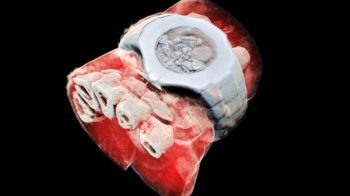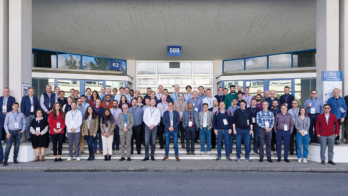Astronomical observations – such as the rotation velocities of galaxies and gravitational lensing – show that more than 80% of the matter in the universe remains invisible. Deciphering the nature of this “dark matter” remains one of the most interesting questions in particle physics and astronomy. The CMS collaboration recently conducted a search for the direct production of dark-matter particles (χ), with especially good sensitivity in the low-mass region that has generated much interest among scientists studying dark matter.
Possible hints of a particle that may be a candidate for dark matter have already begun to appear in the direct-detection experiments; most recently the CDMS-II collaboration reported the observation of three candidate events in its silicon detectors with an estimated background of 0.7 events. This result points to low masses, below 10 GeV/c2, as a region that should be particularly interesting to search. This mass region is where the direct-detection experiments start to lose sensitivity because they rely on measuring the recoil energy imparted to a nucleus by collisions with the dark-matter particles. For a low-mass χ, the kinetic energy transferred to the nucleus in the collision is small, and the detection sensitivity drops as a result.
The CMS collaboration has searched for hints of these elusive particles in “monojet” events, where the dark-matter particles escape undetected, yielding only “missing momentum” in the event. A jet of initial-state radiation can accompany the production of the dark-matter particles, so a search is conducted for an excess of these visible companions compared with the expectation from Standard Model processes. The results are then interpreted within the framework of a simple “effective” theory for their production, where the particle mediating the interaction is assumed to have high mass. An important aspect of the search by CMS is that there is no fall in sensitivity for low masses.

The monojet search requires at least one jet with more than 110 GeV of energy and has the best sensitivity if there is more than 400 GeV of missing momentum. Events with additional leptons or multiple jets are vetoed. After event selection, 3677 events were found in the recent analysis, with an expectation from Standard Model processes of 3663 ± 196 events. The contribution from electroweak processes dominate this expectation, either from pp → Z+jets with the Z decaying to two neutrinos or from pp → W+jets, where the W decays into a lepton and neutrino, while the lepton escapes detection.
With no significant deviation from the expectation from the Standard Model, CMS has set limits on the production of dark matter, as shown in the figures of the χ–nucleon cross-section versus χ mass. The limits show that CMS has good sensitivity in the low-mass regions of interest, for both spin-dependent and spin-independent interactions.
Further reading
CMS collaboration CMS-PAS-EXO-12-048.





